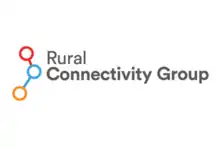Rural Connectivity Group
The Rural Connectivity Group (RCG) is a joint venture by New Zealand’s mobile network operators – Vodafone, Spark, 2degrees. Crown Infrastructure Partners has contracted with the Rural Connectivity Group to bring 4G mobile and wireless broadband coverage to rural New Zealand under the Rural Broadband Initiative Phase Two and the Mobile Black Spot Fund.[1][2][3]
 | |
| Rural Connectivity Group | |
| Industry | Telecommunications |
| Founded | 2017 |
| Headquarters | Level 20, Lumley Centre, 88 Shortland Street, Auckland , New Zealand |
Area served | |
Key people |
|
| Website | http://www.thercg.co.nz/ |
The RCG will build a minimum of 400 new mobile cell-sites, delivering high speed wireless broadband to at least 30,000 additional rural New Zealand households. This will increase New Zealand’s mobile land coverage area by up to 25 per cent, and deliver mobile calling and data service to a further potential 780 kilometres of New Zealand’s state highways. It aims to provide high-speed broadband to the greatest possible number of rural users and improve mobile on state highways and at key visitor destinations.[4]
All three mobile network operators will share spectrum, network equipment and have one set of antennae on each tower, using Multi Operator Core Network (MOCN) technology.[5]
Coverage and rollout
As of June 2018 one site had been installed at Haast on the West coast of the South Island.[6] It was fast tracked due to lobbying from locals citing safety issues.[7] It is only 3G initially (with satellite back-haul) and will be later upgraded to 4G when suitable infrastructure is available.[8]
The original contract builds were due for completion by the end of 2022 however the new schedule (May 2018) aims to have them substantially finished by the end of 2021 – a year earlier than previously planned.[9]

References
- "RBI2 bidders at Rural Connectivity Symposium - Scoop News". www.scoop.co.nz.
- "Extra $270m for rural broadband 'more than Federated Farmers was expecting'". Stuff.
- "Vodafone, Spark and 2degrees submit joint proposal to enhance broadband and mobile services for rural communities - Vodafone News". news.vodafone.co.nz.
- "Rural Broadband Initiative Phase Two (RBI2)/Mobile Black Spots Fund (MBSF)".
- "Mobile carriers forge partnership to snare all the public funds for rural upgrade". Stuff.
- "New mobile coverage for Haast - Scoop News". www.scoop.co.nz.
- sarah.harris@nzherald.co.nz, Sarah Harris Reporter, NZ Herald (16 January 2018). "Haast township lobbies for cellphone reception to save lives" – via www.nzherald.co.nz.
{{cite web}}: CS1 maint: multiple names: authors list (link) - "First tower completed by rural venture in Haast".
- "Accelerated timetable: rural broadband and mobile coverage - Scoop News". www.scoop.co.nz.
- "Haast gains mobile services as Rural Connectivity Group switched on new tower – Rural Connectivity Group". www.thercg.co.nz.